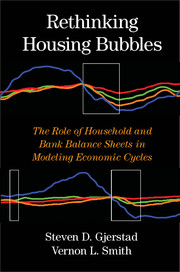 Rethinking Housing Bubbles
Rethinking Housing Bubbles Published online by Cambridge University Press: 05 June 2014
Cassano agreed to meet with all the big Wall Street firms and discuss the logic of their deals – to investigate how a bunch of shaky loans could be transformed into AAA-rated bonds. Together with [Eugene] Park and a few others, Cassano set out on a series of meetings with Morgan Stanley, Goldman Sachs, and the rest – all of whom argued how unlikely it was for housing prices to fall all at once. “They all said the same thing,” says one of the traders present. “They’d go back to historical real-estate prices over 60 years and say they had never fallen all at once.”
– Michael Lewis, Vanity Fair, July 2009It’s a pretty unlikely possibility. We’ve never had a decline in house prices on a nationwide basis. So, what I think is more likely is that house prices will slow, maybe stabilize, might slow consumption spending a bit. I don’t think it’s gonna drive the economy too far from its full employment path, though…
– Ben Bernanke, CNBC Interview, July 1, 2005Two Types of Markets: The Good and the Sometimes Ugly
This chapter summarizes findings from two distinct types of experimental markets that are directly relevant to understanding the sources of both stability and instability in the macroeconomy: (1) the class of nondurable consumed goods and services that constitute about 75 percent of U.S. private expenditures (i.e., GDP minus government expenditures); and (2) asset markets, particularly those in which the items traded have long lives and whose market value, therefore, may be importantly influenced by the future price expectations of the participants (prominent examples include houses, securities, and commercial real estate). The parallels between the laboratory and the economy in each of these two cases suggest underlying modes and principles of human behavior that are similar – conditional on the differing characteristics of the items being traded in these two broad categories of economic activity.
To save this book to your Kindle, first ensure no-reply@cambridge.org is added to your Approved Personal Document E-mail List under your Personal Document Settings on the Manage Your Content and Devices page of your Amazon account. Then enter the ‘name’ part of your Kindle email address below. Find out more about saving to your Kindle.
Note you can select to save to either the @free.kindle.com or @kindle.com variations. ‘@free.kindle.com’ emails are free but can only be saved to your device when it is connected to wi-fi. ‘@kindle.com’ emails can be delivered even when you are not connected to wi-fi, but note that service fees apply.
Find out more about the Kindle Personal Document Service.
To save content items to your account, please confirm that you agree to abide by our usage policies. If this is the first time you use this feature, you will be asked to authorise Cambridge Core to connect with your account. Find out more about saving content to Dropbox.
To save content items to your account, please confirm that you agree to abide by our usage policies. If this is the first time you use this feature, you will be asked to authorise Cambridge Core to connect with your account. Find out more about saving content to Google Drive.